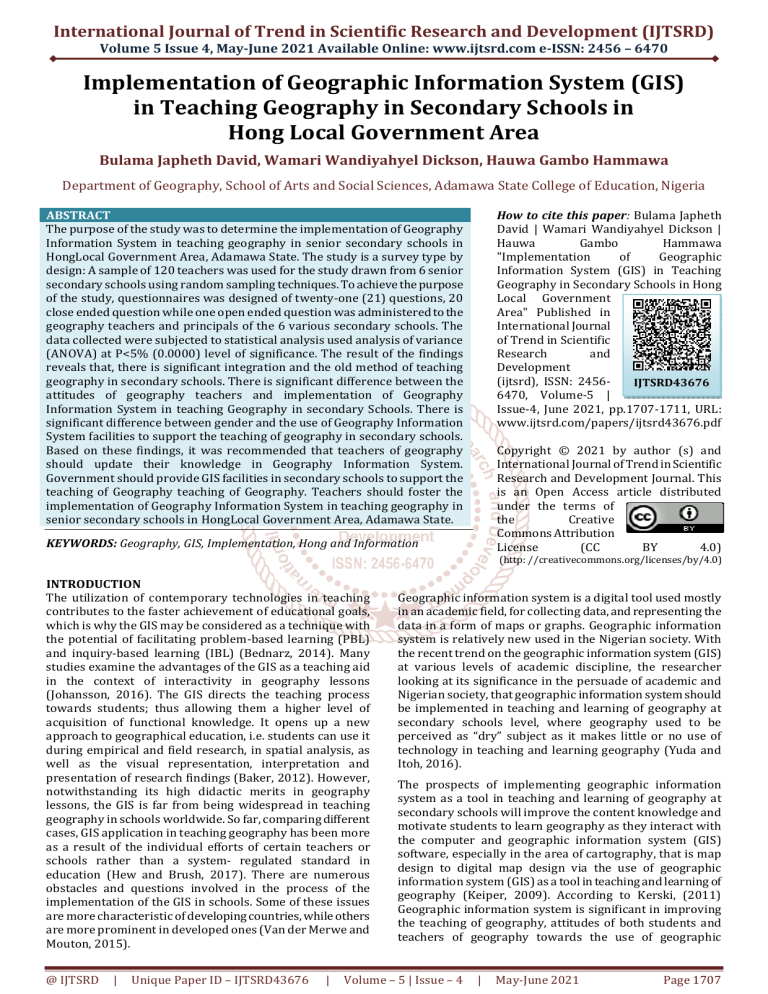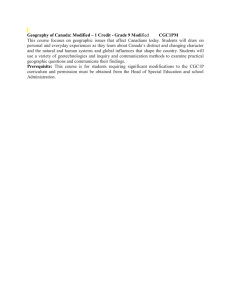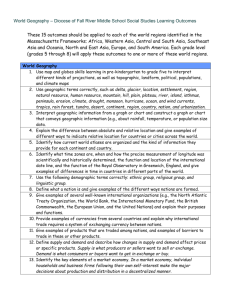
International Journal of Trend in Scientific Research and Development (IJTSRD)
Volume 5 Issue 4, May-June 2021 Available Online: www.ijtsrd.com e-ISSN: 2456 – 6470
Implementation of Geographic Information System (GIS)
in Teaching Geography in Secondary Schools in
Hong Local Government Area
Bulama Japheth David, Wamari Wandiyahyel Dickson, Hauwa Gambo Hammawa
Department of Geography, School of Arts and Social Sciences, Adamawa State College of Education, Nigeria
How to cite this paper: Bulama Japheth
David | Wamari Wandiyahyel Dickson |
Hauwa
Gambo
Hammawa
"Implementation
of
Geographic
Information System (GIS) in Teaching
Geography in Secondary Schools in Hong
Local Government
Area" Published in
International Journal
of Trend in Scientific
Research
and
Development
(ijtsrd), ISSN: 2456IJTSRD43676
6470, Volume-5 |
Issue-4, June 2021, pp.1707-1711, URL:
www.ijtsrd.com/papers/ijtsrd43676.pdf
ABSTRACT
The purpose of the study was to determine the implementation of Geography
Information System in teaching geography in senior secondary schools in
HongLocal Government Area, Adamawa State. The study is a survey type by
design: A sample of 120 teachers was used for the study drawn from 6 senior
secondary schools using random sampling techniques. To achieve the purpose
of the study, questionnaires was designed of twenty-one (21) questions, 20
close ended question while one open ended question was administered to the
geography teachers and principals of the 6 various secondary schools. The
data collected were subjected to statistical analysis used analysis of variance
(ANOVA) at P<5% (0.0000) level of significance. The result of the findings
reveals that, there is significant integration and the old method of teaching
geography in secondary schools. There is significant difference between the
attitudes of geography teachers and implementation of Geography
Information System in teaching Geography in secondary Schools. There is
significant difference between gender and the use of Geography Information
System facilities to support the teaching of geography in secondary schools.
Based on these findings, it was recommended that teachers of geography
should update their knowledge in Geography Information System.
Government should provide GIS facilities in secondary schools to support the
teaching of Geography teaching of Geography. Teachers should foster the
implementation of Geography Information System in teaching geography in
senior secondary schools in HongLocal Government Area, Adamawa State.
Copyright © 2021 by author (s) and
International Journal of Trend in Scientific
Research and Development Journal. This
is an Open Access article distributed
under the terms of
the
Creative
Commons Attribution
License
(CC
BY
4.0)
KEYWORDS: Geography, GIS, Implementation, Hong and Information
(http: //creativecommons.org/licenses/by/4.0)
INTRODUCTION
The utilization of contemporary technologies in teaching
contributes to the faster achievement of educational goals,
which is why the GIS may be considered as a technique with
the potential of facilitating problem-based learning (PBL)
and inquiry-based learning (IBL) (Bednarz, 2014). Many
studies examine the advantages of the GIS as a teaching aid
in the context of interactivity in geography lessons
(Johansson, 2016). The GIS directs the teaching process
towards students; thus allowing them a higher level of
acquisition of functional knowledge. It opens up a new
approach to geographical education, i.e. students can use it
during empirical and field research, in spatial analysis, as
well as the visual representation, interpretation and
presentation of research findings (Baker, 2012). However,
notwithstanding its high didactic merits in geography
lessons, the GIS is far from being widespread in teaching
geography in schools worldwide. So far, comparing different
cases, GIS application in teaching geography has been more
as a result of the individual efforts of certain teachers or
schools rather than a system- regulated standard in
education (Hew and Brush, 2017). There are numerous
obstacles and questions involved in the process of the
implementation of the GIS in schools. Some of these issues
are more characteristic of developing countries, while others
are more prominent in developed ones (Van der Merwe and
Mouton, 2015).
@ IJTSRD
|
Unique Paper ID – IJTSRD43676
|
Geographic information system is a digital tool used mostly
in an academic field, for collecting data, and representing the
data in a form of maps or graphs. Geographic information
system is relatively new used in the Nigerian society. With
the recent trend on the geographic information system (GIS)
at various levels of academic discipline, the researcher
looking at its significance in the persuade of academic and
Nigerian society, that geographic information system should
be implemented in teaching and learning of geography at
secondary schools level, where geography used to be
perceived as “dry” subject as it makes little or no use of
technology in teaching and learning geography (Yuda and
Itoh, 2016).
The prospects of implementing geographic information
system as a tool in teaching and learning of geography at
secondary schools will improve the content knowledge and
motivate students to learn geography as they interact with
the computer and geographic information system (GIS)
software, especially in the area of cartography, that is map
design to digital map design via the use of geographic
information system (GIS) as a tool in teaching and learning of
geography (Keiper, 2009). According to Kerski, (2011)
Geographic information system is significant in improving
the teaching of geography, attitudes of both students and
teachers of geography towards the use of geographic
Volume – 5 | Issue – 4
|
May-June 2021
Page 1707
International Journal of Trend in Scientific Research and Development (IJTSRD) @ www.ijtsrd.com eISSN: 2456-6470
information system (GIS) technology in teaching and
learning at secondary schools (Thomas and Steven, 2013).
The implementation of geographic information system in
teaching geography at secondary schools will make the
students to overcome mechanical aspects of the use of
geographic information system, in map design, data-base
analyses, and it will give the students opportunity to produce
maps and analyzing geographical data. The geographic
information system has the potentials to facilitate the use of
problem based learning and inquiring based learning
methods in the integration of geographic information system
(GIS) into the classroom for teaching and learning
geography, Wiegand, (2011) and Baker, (2013). Therefore,
this study needs to conduct an investigation into the facilities
and human resources that are available to implement
geographic information system (GIS) in teaching and
learning geography, with relevance to its use in secondary
schools in Hong Local Government Area of Adamawa State.
Statement of the Problem
Geographic information system (GIS) is one of the major
recent tool used in teaching Geography mostly at the high
institutional academic level. It is a set of instruction or
programme that involve the use of computer hardware
which is Geographic Information system (GIS). In this recent
years, there is a trend on the use of geography information
system in the Adamawa State, looking at the importance of
the programme to both academic and other organization in
Nigerian society, has prompted the researcher to find the
extent on the prospects of implementing Geographic
Information System in teaching geography in secondary
schools, in Hong Local Government Area of Adamawa State.
Purpose of the Study
The purpose of the study is to assess the effectiveness of
Geographic Information System (GIS) on students academic
achievement in teaching and learning Geography in
secondary schools in Hong Local Government Area,
Adamawa State. The specific objectives are to:
1. Determine the difference between the old method of
teaching geography and the use of Geographic
Information System (GIS) in teaching Geography in
secondary schools.
2. Examine if there is differences between the attitudes of
Geography teachers towards implementing Geographic
Information System in teaching geography in secondary
schools.
3. Ascertain whether there is difference between genders
in the use of Geographic information System (GIS)
facilities to support teaching geography in secondary
schools.
Research Questions
The following research questions were formulated to guide
the study.
1. What is the difference between the old method of
teaching Geography and the use of Geographic
Information System (GIS) in teaching geography in
secondary schools?
2. What are the attitudes of Geography teachers toward
implementing Geographic Information System (GIS) in
teaching geography in secondary schools?
3. What are difference between genders in the use of
Geographic information System (GIS) facilities to
support teaching geography in secondary schools?
@ IJTSRD
|
Unique Paper ID – IJTSRD43676
|
Research Hypothesis
The following research hypothesis will be tested for this
study.
H01: There is no significant differences between Geographic
Information system (GIS) in integration and other method of
teaching geography in secondary schools.
H02: There is no significant differences between the attitudes
of geography teachers and the implementation Geographic
Information System (GIS) in teaching geography in
secondary schools.
H03: There is no significant differences between genders in
the use of Geographic information System (GIS) facilities to
support the teaching geography in secondary schools.
METHODS AND MATERIALS
Research Design
The research design adopted for this research work is the
survey method. Both the strategy and the plan imply how the
research objectives will be obtained and how the problem
will be solved. The researcher used structured and
unstructured questionnaire method to get information and it
was administered to the respondents.
Population of the Study
Esan and Okafor in Oloyiwala, (2007) described population
as the aggregate of all units in a target universe. It is also a
group of interest to the researcher. Therefore, the population
of this study consist of all the senior public secondary school
teachers in Hong Local Government Area.
Sample and Sampling Techniques
While sampling is the process of selecting a number of
individuals represent the larger group from which they were
selected. Therefore, from the population of the study, a total
sample of 120 senior public secondary school teachers made
up of males and females was obtained. The teachers were
selected from 6 schools out of the 15 senior public secondary
schools and 20 teachers from each of the schools selected for
the study. The random sampling technique was chosen
because it gave every member of the population equal
chance to be selected. It also ensures that the sample draw is
a representative of the population from which it is drawn, so
that the result can easily be generalized to the larger
population and avoid bias.
Instrument for Data Collection
The instrument used for data collection for this study
research work was the designed structured and
unstructured of questionnaire. The instrument consist of
(21) question, and is divided into two (2) sections. Section A,
contain the respondents Bio data, such as gender,
qualification, marital status and occupation. Section B, is the
respondents option on the prospect of implementing
geographic information system (GIS) in teaching and
learning geography in secondary schools. In conducting this
research, questionnaire was used to obtain data, twenty one
(21) close-ended questions was used and also two (2) openended question was also used to gather data bases on
respondent suggestion and advice. The likert type scale were
used, the subjects are asked to respond to each item of given
degrees of agreement or disagreement attitude statements
were designed along the likert scale as seen below: (a)
Strongly agree [SA], (b) agree [A], (c) disagree [D], (d)
strongly disagree [SD], (e) undecided [UD]. The beginning of
this questionnaire was made up of an introduction and at the
same time request to the respondent.
Volume – 5 | Issue – 4
|
May-June 2021
Page 1708
International Journal of Trend in Scientific Research and Development (IJTSRD) @ www.ijtsrd.com eISSN: 2456-6470
Validity and Reliability of Instrument
Validity of an instrument used in collecting data is the extent
to which instrument is accurately measured in a quantitative
study. While reliability is the consistency to the accuracy of
an instrument. A is the extent to which a research
instrument consistently have the same result, is used in the
same situation on repeated occasions (Bannigam, K., et al,
2009). The reliability of the instrument that contain twenty
one (21) questions, was performed using Cronbach alpha.
The coefficient obtained was 0.976 (9.76%) above the
threshold of 0.70 (70%) as argued by Nually, (1978). The
validity of the instrument was satisfied by the supervisor to
ascertain the instrument face and content validity.
Method of Data Collection
The researcher collected the data personally after
administering the questionnaire to the respondents, when
they were through with filling of the items.
Method of Data Analysis
The returned questionnaire were checked by the researcher
to ascertain proper filling. They were sorted out for easy
analysis. The data obtained were calculated. The
respondents’ opinions were converted into frequencies and
percentage, and analyzed by item. The researcher made use
of statistical test, to test the data. These are frequencies were
used to present information on data collected. The data was
organized in table of percentage. The following statistical
techniques was used i.e
Where ‘F’ represents the number of respondents to a
particular item or variable.
While “N” represents the number of represents the number
of respondents to a particular item or variable. The
hypotheses was tested using ANOVA in order to ascertain
the relevant differences. This test was done using Statistical
Packages for Social Science (SPSS) 21.
RESULTS AND DISCUSSION
After analyzing the return copies of the administered questionnaire, the scores were interpreted to percentage (%) to enhance
easy and meaningful analysis of the data. The hypothesis were tested using t-test in order to ascertain the radiant difference.
Table 1: Distribution of respondents as to whether Geographic Information System will promote studying of
Geography
Responses
Frequency Percent Valid percent Cumulative percent
Strongly disagreed
7
5.8
5.8
5.8
Disagreed
12
10.0
10.0
15.8
Undecided
10
8.3
8.3
24.2
Agreed
40
33.3
33.3
57.5
Strongly Agreed
51
42.5
42.5
100.0
Total
120
100.0
100.0
From the above tables shows that 7(5.8%) of the respondents strongly disagreed with the above statement, 12(10.0%) of the
respondents disagreed, while 10 (8.3%) of the respondents were undecided, 40(33.3) of the respondent were clearly agree
with GIS will promote the study of geography, 51(42.5%) of the respondents were strongly agree of the statement above. This
analysis shows that, majority of the respondents were of the motion that Geographic Information System will promote the
study of Geography.
Table 2: Distribution of the respondents as to whether secondary schools does not have Geographic Information
System (GIS) facilities for teaching Geography.
Responses
frequency Percent Valid percent Cumulative percent
Strongly disagreed
4
3.3
3.3
3.3
Disagreed
5
4.2
4.2
7.5
Undecided
6
5.0
5.0
12.5
Agreed
56
46.7
46.7
59.2
Strongly Agreed
49
40.8
40.8
100.0
Total
120
100.0
100.0
The table above shows that 4(3.3%) of the respondents strongly disagreed with the above statement, 5(4.2%) of the
respondents disagreed with the statement, while 6(5.0%) of the respondents were undecided, 56(46.7%) agree with the
statement as to whether secondary schools does not have Geographic Information System (GIS) facilities for teaching
Geography, 49(40.8%) of the respondents were strongly agree with the above statement. From that analysis above indicate
that majority agree that secondary schools does not have GIS facilities for teaching Geography.
Table 3: Distribution of the respondents as to whether secondary schools have human resources to implementing
Geographic Information System (GIS) in teaching Geography
Responses
frequency Percent Valid percent Cumulative percent
Strongly disagreed
10
8.3
8.3
8.3
Disagreed
13
10.8
10.8
19.1
Undecided
15
12.5
12.5
31.6
Agreed
44
36.7
36.7
68.3
Strongly Agreed
38
31.7
31.7
100.0
Total
120
100.0
100.0
@ IJTSRD
|
Unique Paper ID – IJTSRD43676
|
Volume – 5 | Issue – 4
|
May-June 2021
Page 1709
International Journal of Trend in Scientific Research and Development (IJTSRD) @ www.ijtsrd.com eISSN: 2456-6470
Table 3 above shows that 10(8.3%) of the respondents strongly disagreed with the above statement, 13(10.8%) of the
respondents disagreed with the statement of whether secondary schools have human resources to implements Geographic
Information System (GIS) in teaching Geography, 15(12.5%) of the respondents were undecided to the above statement, while
44(36.7%) of the respondents agree with the above statement, 38(31.7%) of the respondents strongly agreed with the
statement. This analysis indicate from the table above that, majority believe that secondary schools have human resources to
implement GIS in teaching Geography in secondary schools.
Table 4: Distribution of the respondent’s suggestion as to whether geographic Information System should be
implemented in secondary schools
Responses
Frequency Percent Valid percent Cumulative percent
Supported (positive)
107
0.90
0.90
0.90
Not supported (negative)
13
0.10
0.10
100
Total
120
100.0
100.0
Table 4 above shows the respondents suggestion as to implementation of Geographic Information System in teaching
Geography in secondary schools. 107(0.90%) of the respondents support the implementation of Geographic Information
System (GIS) in teaching Geography in secondary schools, while 13(0.10%) of the respondents did not support the idea of the
implementing of Geographic Information System in teaching Geography ins secondary schools, the distribution above shows
that, majority agreed with the idea. This analysis therefore, indicate that Geographic Information System should be
implemented in teaching of geographic in secondary schools. According to the responses gathered on question (21) the opened
ended statement, the respondents gave some advice to schools authorities.
From the recommendation made by most of the respondents, the following had been dawn: school authorities should provide
and install Geographic Information System facilities, such as GIS laboratory, computer hardware and software, Generator for
constant power supply etc. Schools authorities should send teachers of Geography to update their knowledge in Geographic
Information System. Government should enhance the implementations of Geographic Information System in secondary schools
as to support the programme.
Therefore, teachers of Geography in secondary schools should do their best to see that they implement the Geographic
Information System as a new set of tools use in teaching Geography.
Hypotheses Testing
H0: there is no significant difference between Geographic Information System (GIS) integration and the old method of teaching
Geography in secondary schools.
Table 5: Summarized statistic of one-way ANOVA
Items
N
Mean df Mean square F-statistics
New method
101 88.93
Old method
19 42.00
Between groups
1
35221.49
279.04
Within groups
118
126.23
Source: Researcher’s compotation using SPSS, 21.
Significant
0.0000
-
The summary of the one way ANOVA shows that the mean of the new method is 88.93 while the old method is 42.00.the
analysis also shows that, the differences between the two groups is more than that of same group as specified by the mean
square of 35221.49 and 12.23 respectively. The F-distribution statistic (279.038 and the corresponding probability is
0.0000.sicne, the P<5%, we reject the null and accept the alternative hypothesis, which states that there is a significant
difference between GIS integration and the old method of teaching in secondary schools.
Table 6: Hypotheses Two
Items
N Mean df Mean square F-statistics
Positive
98 89.90
Negative
22 44.09
Between groups 1
37699.20
358.27
Within groups
118
105.23
Source: Researcher’s compotation using SPSS, 21.
Significant
0.0000
-
The result on the table above shows that, that mean of teachers with positive attitude toward GIS is 89.90 and 44.00 is for
teachers ‘with negative dispositions. The mean square of 37699.20 shows that, the differenced of 105.23. the F-statistic is
358.27,and the significant value is 0.0000 (P<5%) these results leads to the conclusion that we reject the null and accept the
alternative hypothesis, where states that, there is significant difference between the attitude of Geography teachers and
implantation of Geographic Information System in teaching Geography in secondary schools.
Table 7: Hypotheses Three
Items
N Mean df Mean square F-statistics
Male
79 94.19
Female
41 57.05
Between groups 1
37233.95
341.064
Within groups
118
109.170
Source: Researcher’s compotation using SPSS, 21.
@ IJTSRD
|
Unique Paper ID – IJTSRD43676
|
Volume – 5 | Issue – 4
|
Significant
0.0000
-
May-June 2021
Page 1710
International Journal of Trend in Scientific Research and Development (IJTSRD) @ www.ijtsrd.com eISSN: 2456-6470
The analysis on the table above shows that male have the highest mean of 94.19 and their counterpart have 57.05. The sum of
square between the groups (37237.95) is less than that of the within, the group mean (109.170).the F-statistics is 342.064 and
the significant value is 0.0000(P<5%). Based on the value of the probability, it is also logical to conclude that we reject the null
hypothesis, and accept the alternative, which states that there is a significant differences between genders in the use of
Geographic Information System (GIS) to support the teaching of geography in secondary schools.
Findings
In the course of this research work, the researcher was able
to come out with the following findings:
1.
That the contents of Geographic Information System has
a great influence on Geography.
2.
The result also shows that some Geography teachers has
negative attitude towards implementing Geographic
Information System. Thus encourage their colleagues
not to implement.
3.
The result of the findings also shown that, teachers of
Geography should use the opportunity to support the
implementation of Geographic Information System in
teaching Geography in secondary schools.
4.
The research also shown that, there is a relationship
between Geographic Information System (GIS) and
Geography, because they complement each other,
Geographic Information System and Geography.
Conclusion
The important of Geographic Information System (GIS) in
teaching geography in secondary school in Hong cannot be
over emphasized. A thorough examination of these has
revealed that Geographic Information System and geography
are related and both are necessary to complement each
other for the studying of geography. However, in Hon Local
Government Area, the role Geographic Information System
could lay in the teaching of geography in secondary schools
@ IJTSRD
|
Unique Paper ID – IJTSRD43676
|
is limited by Geography Information System, human
resources, in the aspect of GIS and Government support
toward the implementation of Geography Information
System (GIS) in secondary schools. But in spite of these
limitations, the geographic teachers in secondary schools are
willing to implement the GIS in the teaching of geography
whenever the facilities are available in secondary schools.
Recommendations
Based on the result of findings of this study, the following
recommendations are made:
1.
Geography teachers’ in secondary schools should try to
update their knowledge in Geographic Information
System (GIS) to enable them to implement it in their
teaching of geography.
2.
Government and the schools authorities should support
the implementation of Geography Information System
the provision of GIS facilities in secondary schools such
as computer hardware and software.
3.
Geography Information System (GIS) laboratory should
be built in each senior secondary school so that GIS
facilities should be install.
4.
Teachers of geography should faster the implementation
of Geographic Information System in their lesson of
geography whenever the facilities are made available in
secondary schools.
Volume – 5 | Issue – 4
|
May-June 2021
Page 1711





